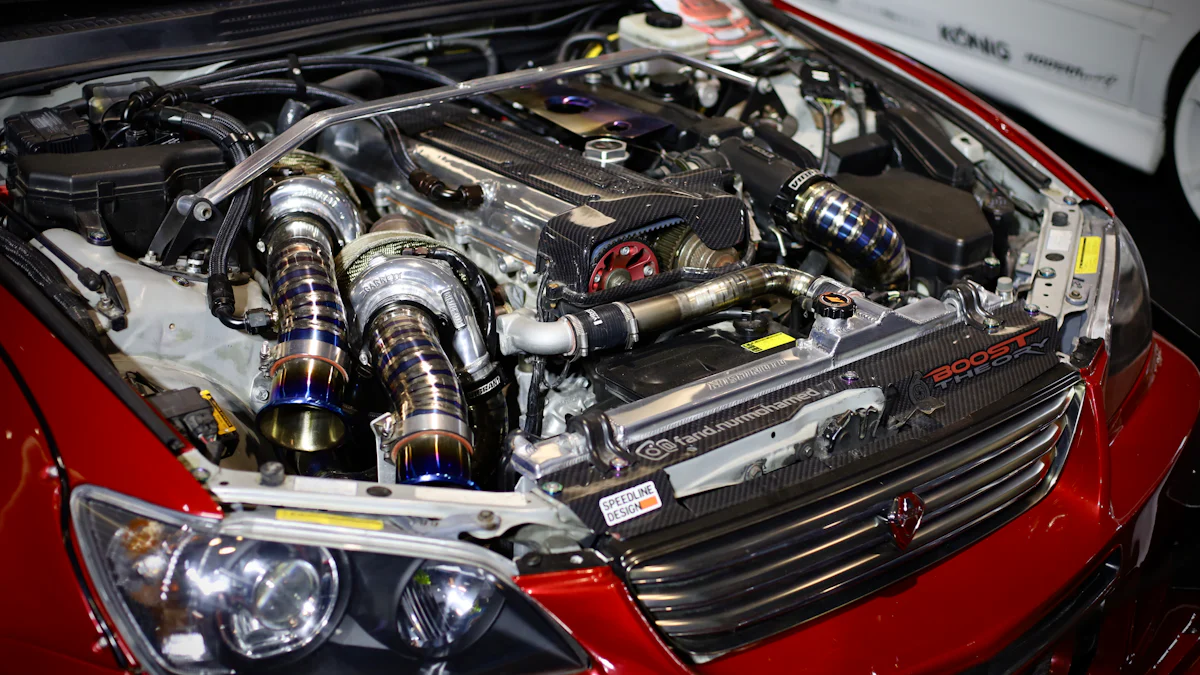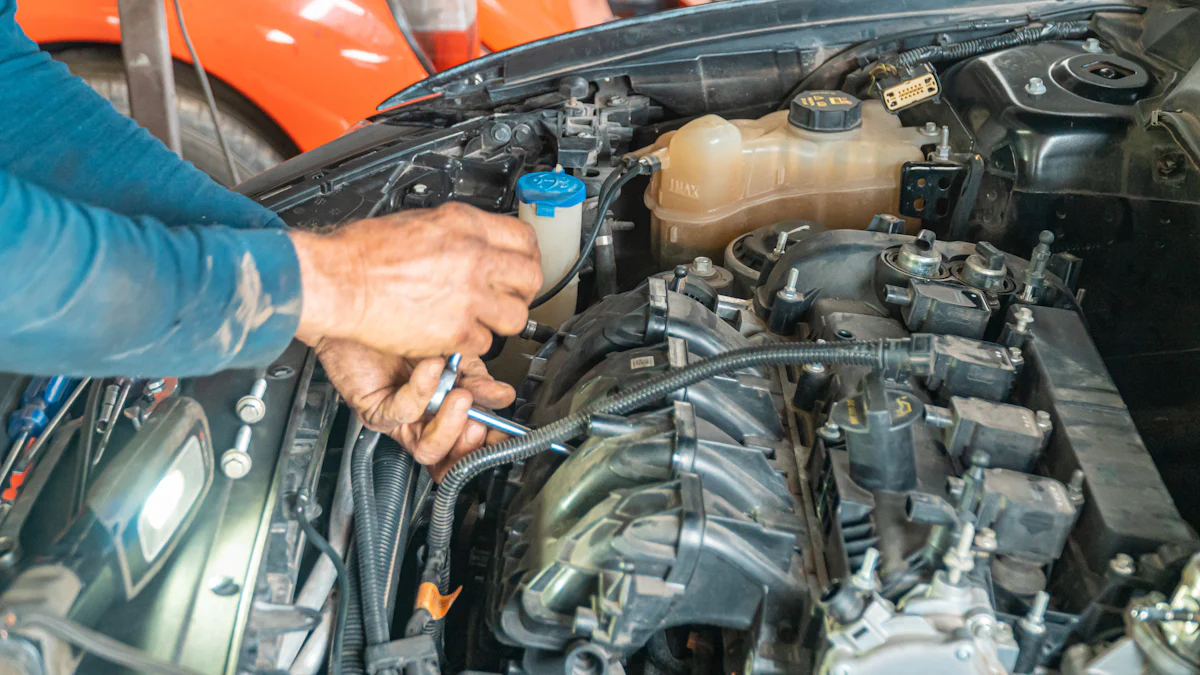
The engine cooler line plays a vital role in your Toyota Lexus. It helps regulate the engine’s temperature by transferring oil to the cooler, ensuring the engine stays within safe operating limits. Without it, your engine could overheat, leading to severe damage. This component not only prevents overheating but also supports optimal performance. By maintaining proper cooling, it extends the engine’s lifespan and keeps it running efficiently. Understanding its importance can help you take better care of your vehicle and avoid costly repairs.
Key Takeaways
- The engine cooler line is essential for regulating your engine’s temperature, preventing overheating, and ensuring optimal performance.
- Regular inspections of the engine cooler line can help identify issues early, saving you from costly repairs and extending your engine’s lifespan.
- Common symptoms of a failing cooler line include oil leaks, engine overheating, and visible damage, which should be addressed promptly.
- When replacing the engine cooler line, always use high-quality parts to ensure durability and compatibility with your Toyota Lexus.
- Proper maintenance, such as keeping the line clean and replacing washers during repairs, is crucial for the longevity of the engine cooler line.
- Investing in reliable replacement parts and following a step-by-step replacement guide can safeguard your engine and enhance its performance.
Importance of the Engine Cooler Line

Role in Engine Cooling
The engine cooler line plays a critical role in maintaining the temperature of your vehicle’s engine. It transfers hot oil from the engine to the cooler, where the oil dissipates heat before returning to the engine. This process ensures that the engine operates within a safe temperature range. Without this component, the engine could overheat, leading to reduced efficiency and potential damage.
By regulating the oil’s temperature, the engine cooler line helps prevent thermal stress on engine components. Excessive heat can cause parts like gaskets and seals to degrade faster. When the cooler line functions properly, it protects these components and ensures the engine runs smoothly. This system is essential for keeping your vehicle reliable, especially during long drives or in hot weather conditions.
Impact on Engine Longevity
A well-maintained engine cooler line directly contributes to the longevity of your engine. Overheating can lead to severe wear and tear on internal parts, such as pistons and cylinders. By keeping the engine cool, the cooler line minimizes this wear, extending the life of these critical components.
Regularly inspecting and maintaining the engine cooler line can save you from costly repairs. A failing cooler line can cause oil leaks, which may result in low oil levels and inadequate lubrication. This lack of lubrication increases friction between moving parts, accelerating engine damage. By ensuring the cooler line remains in good condition, you protect your engine and maintain its performance over time.
“Prevention is better than cure.” Regular maintenance of the engine cooler line not only prevents overheating but also safeguards your investment in your vehicle.
Common Issues and Symptoms
Common Problems with Engine Cooler Lines
Engine cooler lines can face several challenges over time. One common issue is wear and tear caused by prolonged use. The materials in the line, such as rubber or metal, can degrade due to constant exposure to heat and pressure. Cracks or splits may develop in the rubber sections, while metal parts might corrode or weaken.
Another frequent problem involves leaks. These leaks often occur at connection points or along the line itself. A damaged seal or a loose fitting can allow oil to escape, reducing the efficiency of the cooling system. In some cases, blockages can form inside the line. Debris or sludge buildup restricts the flow of oil, which can lead to overheating.
Improper installation or using low-quality replacement parts can also cause problems. If the line isn’t securely fitted or if the materials can’t withstand the engine’s demands, failures are more likely to occur. Regular inspections help you identify these issues early and prevent further damage.
Symptoms of a Failing Engine Cooler Line
Recognizing the symptoms of a failing engine cooler line can save you from costly repairs. One of the most noticeable signs is oil leaks. You might see oil puddles under your vehicle or notice a drop in oil levels. These leaks often indicate damage to the line or its connections.
Another symptom is engine overheating. If the cooler line can’t transfer oil effectively, the engine may struggle to maintain a safe temperature. You might observe the temperature gauge rising higher than usual or experience reduced engine performance.
Visible damage to the line is another warning sign. Cracks, splits, or corrosion on the line’s surface suggest it’s time for a replacement. Additionally, unusual noises from the engine, such as ticking or knocking, could point to inadequate lubrication caused by a failing cooler line.
Pay attention to these symptoms. Addressing them promptly ensures your engine remains protected and performs at its best.
Replacement and Maintenance

Step-by-Step Replacement Guide
Replacing the engine cooler line in your Toyota Lexus requires careful attention to detail. Follow these steps to ensure a successful replacement:
-
Prepare Your Tools and Workspace
Gather the necessary tools, including wrenches, a drain pan, and replacement parts. Park your vehicle on a flat surface and let the engine cool completely. This prevents burns and ensures safety during the process.
-
Drain the Engine Oil
Place a drain pan under the oil cooler line. Loosen the drain plug to remove the oil. Allow all the oil to drain out before proceeding. Dispose of the used oil responsibly.
-
Locate the Engine Cooler Line
Identify the engine cooler line by referring to your vehicle’s manual. It typically connects the engine to the oil cooler. Inspect the line for visible damage or leaks to confirm it needs replacement.
-
Remove the Old Line
Use a wrench to disconnect the fittings at both ends of the cooler line. Be cautious to avoid damaging surrounding components. Remove the old line and clean the connection points to ensure a proper seal for the new line.
-
Install the New Line
Position the replacement engine cooler line and secure it with the fittings. Tighten the connections firmly but avoid over-tightening, which could damage the threads. Ensure the line is properly aligned and free from kinks.
-
Refill the Engine Oil
Add fresh engine oil to the vehicle. Check the oil level using the dipstick and adjust as needed. Start the engine and let it run for a few minutes to circulate the oil. Inspect the new line for leaks.
-
Test and Finalize
Take your vehicle for a short drive to ensure the engine operates smoothly. Recheck the oil level and inspect the cooler line again for any signs of leakage. If everything looks good, the replacement is complete.
“Always double-check your work to ensure the engine cooler line is securely installed and functioning properly.”
Maintenance Tips
Proper maintenance of the engine cooler line can extend its lifespan and prevent unexpected failures. Here are some tips to keep it in top condition:
-
Inspect Regularly
Check the engine cooler line during routine maintenance. Look for cracks, corrosion, or leaks. Early detection of issues can save you from costly repairs.
-
Use High-Quality Parts
Invest in durable replacement parts made from reliable materials. Stainless steel flanges and high-grade rubber components provide better resistance to heat and pressure.
-
Avoid Overheating
Monitor your engine’s temperature gauge. If the engine runs hotter than usual, inspect the cooler line and other cooling system components immediately.
-
Replace Washers During Repairs
Always replace the upper and lower washers when changing the cooler line. This prevents future leaks and ensures a secure fit.
-
Keep the Line Clean
Remove debris or sludge buildup around the cooler line. A clean system allows oil to flow freely, maintaining optimal cooling performance.
By following these maintenance practices, you can ensure the engine cooler line continues to protect your engine and maintain its performance.
Choosing the Right Parts
Factors to Consider When Selecting Replacement Parts
Choosing the right replacement parts for your engine cooler line ensures your vehicle operates efficiently and avoids future issues. You should evaluate several factors before making a decision. Start by confirming compatibility with your Toyota Lexus model. Refer to your vehicle’s manual or consult a trusted mechanic to ensure the part fits perfectly.
Material quality is another critical factor. High-grade materials, such as stainless steel or reinforced rubber, offer better durability and resistance to heat and pressure. These materials reduce the risk of leaks and extend the lifespan of the component. Avoid low-quality parts, as they may fail prematurely and lead to costly repairs.
Price should also guide your decision, but it shouldn’t be the only consideration. While budget-friendly options may seem appealing, they often compromise on quality. Investing in a reliable part saves you money in the long run by preventing frequent replacements.
Lastly, check for warranty coverage. A warranty indicates the manufacturer’s confidence in the product’s quality. It also provides peace of mind, knowing you can replace the part if it fails within the warranty period.
Recommended Brands and Suppliers
Selecting parts from reputable brands ensures reliability and performance. Dorman is a well-known brand that offers high-quality engine cooler line assemblies compatible with Toyota Lexus models. Their products receive positive reviews for durability and precise fit.
OEM (Original Equipment Manufacturer) parts are another excellent choice. These parts match the specifications of the original components in your vehicle. They provide a seamless fit and maintain the performance standards set by Toyota Lexus.
When purchasing replacement parts, choose trusted suppliers. Online platforms like RockAuto and AutoZone offer a wide range of options, including OEM and aftermarket parts. These suppliers provide detailed product descriptions and customer reviews, helping you make an informed decision.
Local auto parts stores can also be a reliable source. They often have knowledgeable staff who can guide you in selecting the right part for your vehicle. Whether you shop online or in-store, prioritize quality and compatibility to ensure your engine cooler line functions effectively.
“Investing in high-quality parts from reputable brands protects your vehicle and ensures long-term performance.”
The engine cooler line plays a crucial role in keeping your engine healthy and performing at its best. Regular inspections and maintenance help you catch potential issues early, preventing costly repairs and ensuring your vehicle runs smoothly. Timely replacement of a worn or damaged line protects your engine from overheating and extends its lifespan. Always choose high-quality parts and follow proper procedures during replacement. By taking these steps, you safeguard your investment and maintain the reliability of your Toyota Lexus for years to come.
FAQ
What is the engine cooler line, and why is it important?
The engine cooler line transfers hot oil from the engine to the cooler, where it dissipates heat before returning to the engine. This process helps regulate the engine’s temperature, preventing overheating. A functioning cooler line ensures your engine operates efficiently and avoids damage caused by excessive heat.
How can I tell if my engine cooler line is failing?
You can identify a failing engine cooler line by looking for specific symptoms. Common signs include oil leaks, visible damage like cracks or corrosion, and unusual noises from the engine. Overheating or a drop in oil levels also indicate potential issues with the cooler line.
How often should I inspect the engine cooler line?
Inspect the engine cooler line during routine maintenance or oil changes. Regular checks help you spot early signs of wear, leaks, or damage. Addressing these issues promptly prevents costly repairs and ensures your engine stays protected.
Can I replace the engine cooler line myself?
Yes, you can replace the engine cooler line yourself if you have the right tools and follow proper procedures. Refer to your vehicle’s manual for guidance. Ensure you drain the oil, remove the old line carefully, and install the new one securely. If unsure, consult a professional mechanic.
What materials should I look for in a replacement engine cooler line?
Choose replacement parts made from high-quality materials like stainless steel or reinforced rubber. These materials resist heat and pressure better, reducing the risk of leaks and extending the component’s lifespan. Avoid low-quality parts that may fail prematurely.
How much does it cost to replace an engine cooler line?
The cost of replacing an engine cooler line varies depending on your vehicle model and the parts used. For a Lexus RX350, the average cost ranges between
216and234, including labor and parts. DIY replacement can save on labor costs.
Are aftermarket parts reliable for engine cooler line replacement?
Aftermarket parts can be reliable if you choose reputable brands. Brands like Dorman offer high-quality aftermarket options compatible with Toyota Lexus models. Always check reviews and ensure compatibility with your vehicle before purchasing.
What happens if I ignore a damaged engine cooler line?
Ignoring a damaged engine cooler line can lead to severe consequences. Oil leaks reduce lubrication, causing friction and wear on engine components. Overheating may occur, leading to costly repairs or even engine failure. Address issues immediately to avoid these risks.
Do I need to replace washers when changing the engine cooler line?
Yes, always replace the upper and lower washers during cooler line replacement. New washers ensure a secure fit and prevent future leaks. Skipping this step increases the risk of oil escaping from the connections.
How can I maintain the engine cooler line to extend its lifespan?
You can maintain the engine cooler line by inspecting it regularly for cracks, corrosion, or leaks. Keep the line clean and free from debris. Use high-quality replacement parts and monitor your engine’s temperature gauge. These practices help ensure the cooler line functions effectively for a long time.
Post time: Dec-27-2024





